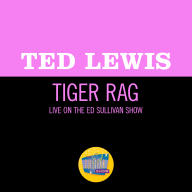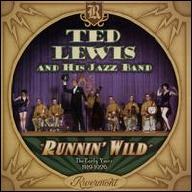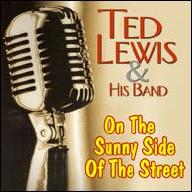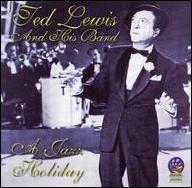Born Theodore Leopold Friedman in Circleville, Ohio, in 1890 (some sources say 1892), he was the son of the owner of a large clothing emporium. His parents hoped he would go into business, but the younger Friedman, to the horror of his parents, was an indifferent student, and, worse still, was drawn to the life of a performer. It all started when he discovered the circus as a boy, and by the time he was in his teens, he had some definite ideas about showmanship, and had acquired some above-average basic musicianship with the clarinet. A stint in business school did nothing to make him forget an entertainment career. By 1906, at age 16, he'd begun working in vaudeville, playing tent shows and other bottom-of-the-bill engagements, and gradually built a reputation for himself. His name change came about through an accident involving his partnership with a fellow named Lewis -- an erroneous marquee billing as "Lewis and Lewis" seemed an omen, and he kept the new name imposed on him. Ted Lewis labored in relative anonymity for most of the '10s, even after arriving in New York. He put his first band -- a five-piece called Ted Lewis His Nut Band -- together in 1916, initially as part of a comedy act. By 1917, he was playing in a band led by pianist Earl Fuller, and then fate played a hand with the arrival of the Original Dixieland Jazz Band in New York. Suddenly, not only was Lewis opened to a new brand of music, but a new opportunity presented itself. The success of the Original Dixieland Jazz Band at a cafe called Reisenweber's turned the latter into the place to be. By sheer luck, Lewis, as part of Fuller's band, was hired by a rival venue, Rector's, to help bring back the customers. It turned out that he not only loved Dixieland jazz, but that, for all of his limitations as a singer, he was appealing in that role, even more so than as a comedian. The two final ingredients to his new persona were his distinctive top hat -- reportedly won in a bet with a carriage driver -- and the catch-phrase, "Is everybody happy?" He began posing it to his audience at Rector's, and it stuck -- and when Lewis and his band (and he soon had his own band) were playing, the answer was a resounding "Yes!" 50 years later, he was still wearing the top hat and asking the question. Soon, Lewis had not only a new band of his own but he'd also opened his own club. By 1919, he was on his way -- he appeared in the Greenwich Village Follies, even financed a production, Ted Lewis' Follies, which failed and cost him much of what he'd made, and he played in productions like the Ziegfeld Midnight Follies and appeared in the revue, Artists and Models.
Lewis was signed to Columbia Records, not yet the giant it was to become but still an important label, in 1919, and released his first single, Wond'ring b/w Blues My Naughty Sweety Gives Me, in October of that year. The following year, he introduced and made the first of several recordings of When My Baby Smiles at Me, which became Lewis' theme song. By the mid-'20s, he was one of Columbia's top-selling artists and one of the world's top entertainers and bandleaders. Although Lewis often took the role of singer himself, mixing his mournful voice with a pleasing personality, there were some notable exceptions -- Ruth Etting cut sides with him, as did Fats Waller, and in 1926, with Sophie Tucker as vocalist, Lewis had one of the most popular records of the year, Some of These Days, which became a million seller. A tour of Europe, including engagements at the Hippodrome and the Kit Kat Club in London, solidified his standing internationally, and the band played all of the top venues in Europe on a subsequent tour. By the end of the '20s, Lewis was so popular and distinctive a musical personality that Columbia devised a customized label design for him, and the silhouette of the bandleader in his top hat now embossed his records. In December of 1929, he signed a new contract with the label guaranteeing him $42,000 plus a royalties on each record pressed, each year for two years. It seemed a bargain to Columbia, for they were getting a great band as well as a popular one. In 1928, Lewis added ex-New Orleans Rhythm Kings trombonist George Brunies to his band, and early the following year, trumpet man Muggsy Spanier came aboard. Their ranks were soon swelled by the arrival of Don Murray, the hot young clarinetist and saxman from the Jean Goldkette band, whose solos gave the Lewis band a new level of sophistication and virtuosity. Lewis recognized the ability of men like Spanier, Brunies, and Murray, and paid his featured soloists well and did his best to keep them happy; in that regard, he was a good bandleader with what turned out to be a great band. Part of his secret was that he recognized his own limitations, but never let them limit him. Lewis himself played clarinet in what was often referred to as "gaspipe" style, overblowing and creating a shrill tone that was very useful on novelty tunes but frowned on by most players in most other settings (though as Rob Bamberger points out in his excellent essay on Lewis, the fingering and control involved in effective "gaspipe" clarinet was just as daunting as any more standard approach to the instrument). He was never reticent to bring in better players, however, and Murray was only the first in a string of clarinetists who would have been the envy of many rival bandleaders.
The lineup of the group was shaken by Murray's tragic death in June of 1929, in a car accident. At the time, the band was shooting their first film, Is Everybody Happy?, a fictionalized retelling of Lewis' life story, for Warner Bros. (which had come to Lewis in search of a musical personality to film, in much the same manner that it had come to Jolson for The Jazz Singer in 1927). He soon recruited a young Chicago-based player, Frank Teschemacher, who was heavily influenced by the cornet playing of Bix Beiderbecke. Lewis, and Teschemacher (who also died in an automobile accident) became friends, but the latter, although willing to record with the band, begged off the group's tours. His replacement was Jimmy Dorsey, who was already a widely idolized clarinetist. Dorsey not only energized the whole band, but proved one of the attractions on the band's 1930 tour of Europe. By then, they were one of the top bands in the country, and their music was at its peak -- their 1930 sides, including Sobbin' Blues, Pts. 1-2 and Aunt Hagar's Blues, were appealing and popular, and they were attracting a lot of jazz listeners thanks to Dorsey et al. It was all going almost too well, and in strange turn of events, Lewis broke up the band at this moment, announcing his retirement in 1930. By 1931, however, he was back in the business, for reasons that were never clear -- he'd reportedly made more than enough money to live comfortably for the rest of his life, although with the nation's financial situation worsening monthly, that might have changed. Additionally, Columbia very much wanted him back. The Lewis band was regrouped with a few changes -- Dorsey, who couldn't abide Lewis' own reed playing, was long gone, but in his place was a promising unknown named Benny Goodman. Alas, Lewis' records from this period, although they featured superb playing, failed to sell the way his '20s sides had -- the Great Depression was in full swing, and few records were getting the sales they deserved, as the economic upheaval spread to virtually every corner of America. Lewis contract with Columbia ended in 1933, and he signed with Decca Records. Lewis was never to enjoy anything like his old success, however -- the swing era had begun, heralded by Benny Goodman's own band, and his brand of Dixieland-based novelty numbers no longer commanded huge sales. He remained a popular personality, however, and his music was always attractive and lively, even if it didn't swing. (Indeed, Bamberger finds a subtle and peculiarly ethnic component to Lewis' music, with elements of klezmer in his playing). Lewis was also a master showman as much as a musician. In hard times, his catch phrase, "Is everybody happy?," didn't seem out-of-place -- it was encouragement to enjoy the music, and there was a lot to enjoy.
Lewis did radio, including The Valspar Paint Program and The Merritt Beer Program -- as late as 1945, he was featured on the Coca Cola Spotlight show -- and he could have written his ticket on the airwaves, but he never liked radio. As a vaudeville-based performer, his was a visual as well as a musical act -- the physical presence, the top hat, the bits of visual humor and dancing were as important as the music, from his point of view. Indeed, one of his most memorable bits was Me and My Shadow, in which he danced on-stage with his spotlight-generated shadow -- eventually a dancer was added to duet with Lewis' shadow on-stage. Lewis' moment as a taste-maker had passed, but he never lost his audience. They might've been frantic to see Benny Goodman, but they'd always pay to see Lewis, and even Goodman was known to drop by for performances by his old employer just to enjoy his work. Lewis continued to play the top clubs in America and Europe before the war, earning top dollar and top billing wherever he played, and made specialty appearances in films like Hold That Ghost (starring Abbott Costello) -- in 1943, years after Lewis' last big-selling record, Columbia Pictures even remade Is Everybody Happy? As late as 1950, he still recorded for Decca (My Blue Heaven, Blue Skies, etc.), though this wasn't a major or serious effort, nor were the dance sides he cut for the short-lived RKO label in the late '50s. Concert work was what interested Lewis, and he got that, plus occasional appearances on television, right up to the end of the '60s at the country's biggest resorts and hotels. He played his last show, still wearing the top hat, at the Desert Inn in Las Vegas in 1967, 50 years after he ventured into the music business.
Ted Lewis was almost -- but not quite -- more of a personality than a musician. On one level he was like Al Jolson, but with a more genial and low-key personality, a clarinet at the ready, and a handpicked band behind him; but he was also less and more than that. Unlike Jolson, he had no voice to speak of, and yet people loved hearing him talk his way through lyrics, almost like a rapper; he wasn't a great musician, but he hired great ones and let them do their work the way they liked; he even had a feel for blues, to judge from his work with Fats Waller on Dallas Blues and Royal Garden Blues. Even at the end of the 20th century, it's impossible to listen to Lewis' best work and not smile, amid the urge to dance and to laugh -- Lewis' music still makes audiences answer "Yes!" to his question "Is everybody happy?" ~ Bruce Eder, Rovi
















